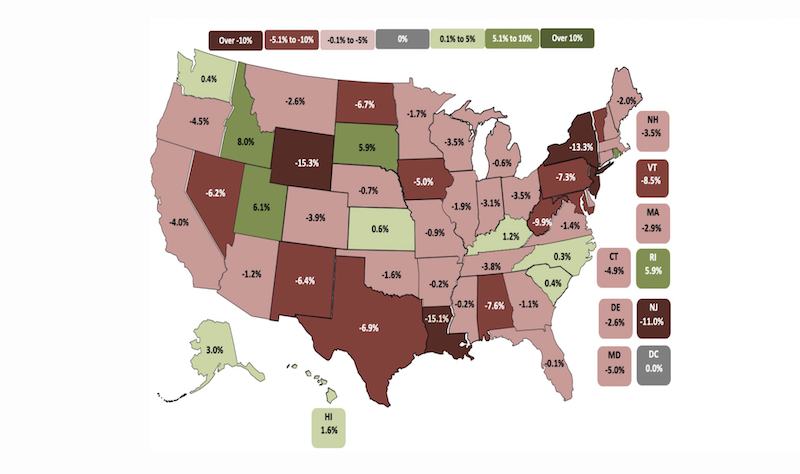Construction employment in June remained below the levels reached before the pre-pandemic peak in February 2020 in 39 states, according to an analysis by the Associated General Contractors of America of government employment data released today. Association officials noted that many construction firms are struggling to cope with supply chain challenges and rising materials prices, which is undermining demand for new projects and impacting firms’ ability to hire new workers.
“The construction industry is a long way from full recovery in most states, in spite of a hot homebuilding market in many areas,” said Ken Simonson, the association’s chief economist. “Soaring materials costs, long production times for key items, and delayed deliveries are causing owners to postpone projects.”
From February 2020—the month before the pandemic caused project shutdowns and cancellations—to last month, construction employment increased in only 11 states and was flat in the District of Columbia. New York shed the most construction jobs over the period (-54,300 jobs or -13.3%), followed by Texas (-54,100 jobs, -6.9%) and California (-36,500 jobs, -4.0%). Wyoming recorded the largest percentage loss (-15.3%, -3,500 jobs), followed by Louisiana (-15.1%, -20,700 jobs) and New York.
Of the states that added construction jobs since February 2020, Utah added the most (7,000 jobs, 6.1%), followed by Idaho (4,400 jobs, 8.0%), South Dakota (1,400 jobs, 5.9%) and Rhode Island (1,200 jobs, 5.9%). The largest percentage gain was in Idaho, followed by Utah, Rhode Island, and South Dakota.
From May to June construction employment decreased in 25 states, increased in 24 states and D.C., and held steady in Maine. The largest decline over the month occurred in New York, which lost 6,900 construction jobs or 1.9%, followed by Pennsylvania (-4,100 jobs, -1.6%) and Texas (-3,300 jobs, -1.3%). The steepest percentage declines since May occurred in Vermont (-3.5%, -500 jobs), followed by New York, Alabama (-1.9%, -1,700 jobs), and North Dakota (-1.9%, -500 jobs).
Georgia added the most construction jobs between May and June (5,700 jobs, 2.9%), followed by Kentucky (2,700 jobs, 3.4%) and Florida (2,500 jobs, 0.4%). Kentucky had the largest percentage gain for the month, followed by Alaska (3.0%, 500 jobs) and Georgia.
Association officials cautioned that construction employment is unlikely to grow in many parts of the country until many of the supply chain challenges impacting firms improve. They added that the President could help by removing tariffs on key construction materials. They added that ending the unemployment supplements would add to the pool of workers for manufacturers, shippers, and construction firms to hire.
“Easing tariffs will help, but what the construction supply chain needs are workers to manufacture the products, ship them to contractors and build the projects the economy demands,” said Stephen E. Sandherr, the association’s chief executive officer. “Unemployment supplements helped families survive the pandemic-related lock downs, but they are undermining the post-pandemic recovery.”
View state February 2020-June 2021 data, 16-month rankings, 1-month rankings, and map.
Related Stories
Multifamily Housing | Feb 15, 2018
United States ranks fourth for renter growth
Renters are on the rise in 21 of the 30 countries examined in RentCafé’s recent study.
Market Data | Feb 1, 2018
Nonresidential construction spending expanded 0.8% in December, brighter days ahead
“The tax cut will further bolster liquidity and confidence, which will ultimately translate into more construction starts and spending,” said ABC Chief Economist Anirban Basu.
Green | Jan 31, 2018
U.S. Green Building Council releases annual top 10 states for LEED green building per capita
Massachusetts tops the list for the second year; New York, Hawaii and Illinois showcase leadership in geographically diverse locations.
Industry Research | Jan 30, 2018
AIA’s Kermit Baker: Five signs of an impending upturn in construction spending
Tax reform implications and rebuilding from natural disasters are among the reasons AIA’s Chief Economist is optimistic for 2018 and 2019.
Market Data | Jan 30, 2018
AIA Consensus Forecast: 4.0% growth for nonresidential construction spending in 2018
The commercial office and retail sectors will lead the way in 2018, with a strong bounce back for education and healthcare.
Market Data | Jan 29, 2018
Year-end data show economy expanded in 2017; Fixed investment surged in fourth quarter
The economy expanded at an annual rate of 2.6% during the fourth quarter of 2017.
Market Data | Jan 25, 2018
Renters are the majority in 42 U.S. cities
Over the past 10 years, the number of renters has increased by 23 million.
Market Data | Jan 24, 2018
HomeUnion names the most and least affordable rental housing markets
Chicago tops the list as the most affordable U.S. metro, while Oakland, Calif., is the most expensive rental market.
Market Data | Jan 12, 2018
Construction input prices inch down in December, Up YOY despite low inflation
Energy prices have been more volatile lately.
Market Data | Jan 4, 2018
Nonresidential construction spending ticks higher in November, down year-over-year
Despite the month-over-month expansion, nonresidential spending fell 1.3 percent from November 2016.

















